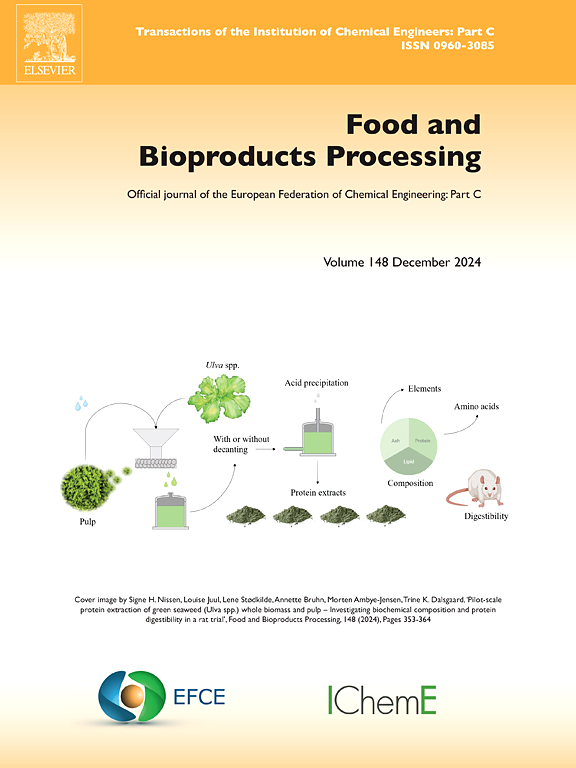银/羧甲基纤维素/细菌纤维素/三棱菊提取物气凝胶复合材料的合成、表征和抗菌性能评估
IF 3.5
2区 农林科学
Q2 BIOTECHNOLOGY & APPLIED MICROBIOLOGY
引用次数: 0
摘要
肉类、加工食品和新鲜食品的食品包装通常配有吸附垫,以调节湿度。然而,大多数吸附剂都来自合成聚合物材料。人们对功能性包装材料的要求越来越高,这些材料不仅要耐用、经济、设计合理,还要能延长产品的保质期。有多项研究报告称,蝴蝶豌豆(Clitoria ternatea L.)花和银纳米粒子具有抗菌活性。本研究旨在合成由羧甲基纤维素(CMC)、细菌纤维素(BC)和蝶形花提取物制成的新型气凝胶复合材料,作为食品包装中的吸附材料。BC 用作增强剂。复合材料是通过银溶液和羧甲基纤维素反应,然后加入细菌纤维素和 C. ternatea 提取物合成的。本研究使用了三种不同比例的 C. ternatea 提取物,即 0.5%、1% 和 2%(AT1、AT2、AT3)。采用磁盘扩散法和微量稀释法对这些气凝胶复合材料进行了针对四种致病菌(金黄色葡萄球菌、大肠杆菌、绿脓杆菌和鼠伤寒沙门氏菌)的测试。利用 X 射线衍射(XRD)、扫描电子显微镜(SEM)、X 射线荧光(XRF)、傅立叶变换红外光谱(FTIR)和颜色分析对气凝胶复合材料进行了表征。结果表明,AT3 对绿脓杆菌、伤寒杆菌和金黄色葡萄球菌具有良好的抗菌活性,抑菌区分别为 10.14 毫米、11.63 毫米和 7.69 毫米;而复合 AT2 对大肠杆菌具有良好的抑菌作用,抑菌区为 9.82 毫米。这些气凝胶复合材料具有良好的抗菌活性,可用作食品包装中的吸附垫,延长食品的保质期。本文章由计算机程序翻译,如有差异,请以英文原文为准。
Synthesis, characterization, and evaluation of antibacterial properties of silver/ carboxymethyl cellulose/ bacterial cellulose/ Clitoria ternatea extract aerogel composites
Food packaging for meat, processed food, and fresh food is often equipped with adsorbent pads to regulate moisture. However, most adsorbents are derived from synthetic polymer materials. There has been increasing demand for functional packaging materials that are not only durable, cost-effective, and well-designed, but also capable of extending the product shelf-life. Butterfly pea (Clitoria ternatea L.) flowers and silver nanoparticles have been reported to exhibit antibacterial activity in several studies. This study aimed to synthesize novel aerogel composites made of carboxymethyl cellulose (CMC), bacterial cellulose (BC), and C. ternatea flower extracts as adsorbent material in food packaging. BC was used as a reinforcing agent. The composites were synthesized by reacting silver solution and carboxymethyl cellulose, and then adding bacterial cellulose and C. ternatea extracts. Three different ratios of C. ternatea extract i.e. 0.5 %, 1 % and 2 % were used in this study (AT1, AT2, AT3). These aerogel composites were tested against four pathogenic bacteria i.e. Staphylococcus aureus, Eschericia coli, Pseudomonas aeruginosa, and Salmonella Typhimurium using disk diffusion and microdilution methods. The aerogel composites were characterized using X-ray diffraction (XRD), scanning electron microscope (SEM), X-ray fluorescence (XRF), Fourier-transform infrared (FTIR) spectroscopy, and color analysis. The results showed that AT3 had good antibacterial activity against P. aeruginosa, S. Typhimurium, and S. aureus with inhibition zones of 10.14 mm, 11.63 mm, and 7.69 mm, respectively, while composite AT2 had good inhibition against E. coli with the value of 9.82 mm. Equipped with good antibacterial activity, these aerogel composites have excellent potential to be used as adsorbent pads in food packaging to prolong the food shelf-life.
求助全文
通过发布文献求助,成功后即可免费获取论文全文。
去求助
来源期刊

Food and Bioproducts Processing
工程技术-工程:化工
CiteScore
9.70
自引率
4.30%
发文量
115
审稿时长
24 days
期刊介绍:
Official Journal of the European Federation of Chemical Engineering:
Part C
FBP aims to be the principal international journal for publication of high quality, original papers in the branches of engineering and science dedicated to the safe processing of biological products. It is the only journal to exploit the synergy between biotechnology, bioprocessing and food engineering.
Papers showing how research results can be used in engineering design, and accounts of experimental or theoretical research work bringing new perspectives to established principles, highlighting unsolved problems or indicating directions for future research, are particularly welcome. Contributions that deal with new developments in equipment or processes and that can be given quantitative expression are encouraged. The journal is especially interested in papers that extend the boundaries of food and bioproducts processing.
The journal has a strong emphasis on the interface between engineering and food or bioproducts. Papers that are not likely to be published are those:
• Primarily concerned with food formulation
• That use experimental design techniques to obtain response surfaces but gain little insight from them
• That are empirical and ignore established mechanistic models, e.g., empirical drying curves
• That are primarily concerned about sensory evaluation and colour
• Concern the extraction, encapsulation and/or antioxidant activity of a specific biological material without providing insight that could be applied to a similar but different material,
• Containing only chemical analyses of biological materials.
 求助内容:
求助内容: 应助结果提醒方式:
应助结果提醒方式:


